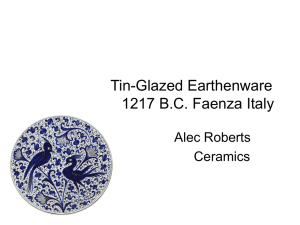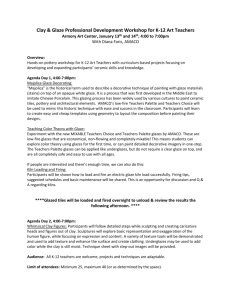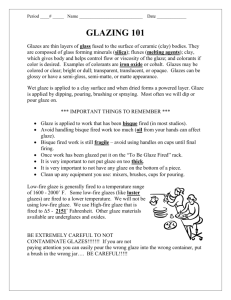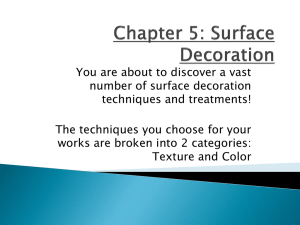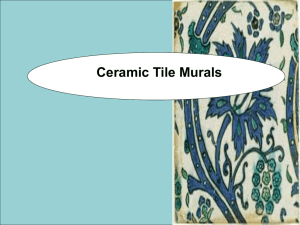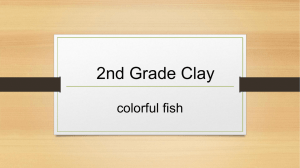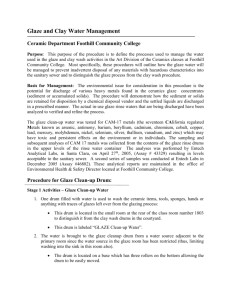Glazing
advertisement
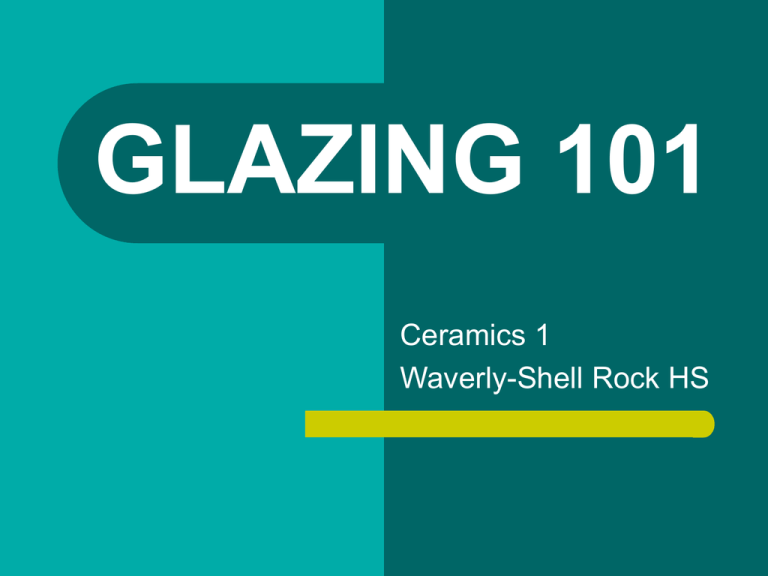
GLAZING 101 Ceramics 1 Waverly-Shell Rock HS GLAZE IS… A liquid suspension of finely ground minerals which is applied on the surface of bisque fired clay. The glaze ingredients will melt together when fired to form a glossy glass-like surface. GLAZE The purpose of a glaze is to: – 1. Decorate or add color to a ceramic piece. – 2. Waterproof a ceramic object. A clay body should be glazed in order to seal pores and make it water-tight. Glazing is generally done by brushing, pouring, dipping or spraying. GLAZE Many different colors are possible using minerals and elements as a basis for colorant. The color of the liquid glaze IS NOT necessarily the color it will be when fired. (Check glaze chart or color tiles for an idea of glaze color) When firing, the objects should be placed about ¼” apart and from the sides of the kiln to prevent the two surfaces from bonding together. CLAY FOR DECORATING The color and texture of clay will have a great impact on the glaze. A light colored clay will have a better color response. The texture of the clay surface can make a nice contrast in the over-all effect of glazing. Glaze in a way to enhance the design of your work, not detract from what should be a well-planned project. GLAZING RULES There rules that need to be followed to help us be successful. RULES FOR GLAZING ** Glaze is expensive, glaze only those works you plan to keep. 1. Rinse off your bisque pieces to remove any oxidation, dust or clay particles. (Glaze will not stick to loose foreign matter.) – Defects from glazing: Blistering, pinholes, crawling, running, cracks and dull sheen to name a few. 2. Remove rough spots before glazing. (No sanding of pots inside building if possible. Use the shop or go outside if sanding is necessary.) RULES FOR GLAZING 3. Be especially careful not to contaminate one glaze with another. (Clean glaze mixer before and after each mixing. ) 4. Wipe off lids and replace them on glaze containers immediately after using. (Make sure you put the correct lid on the correct glaze container! ) RULES FOR GLAZING 5. Check labels, some still contain a small amount of lead which can not be used for holding food or drink. They also can not be sprayed. 6. After glazing your pieces, clean up drips on tables and floor. 7a. WORK CLEAN - Clean off any glaze that sticks to the foot of the clay piece. Bottoms of pots must be absolutely free of glaze or the pot will not be fired. RULES FOR GLAZING 7b. WORK CLEAN - “Dryfoot” all glazed objects prior to firing. 7c. WORK CLEAN- In lieu of “dry footing,” the bottoms of many pieces can use a wax resist method. Wipe off any glaze that beads on the wax. 7d. Be sure to spray water through the airbrush when finished. Glaze will set-up in the tubing and make problems in the future. ADVICE So that the decoration works as a whole with the ceramic piece and that it looks convincing, plan your approach to materials and how to apply them right from the beginning. Often, a piece can be PAINTED with acrylic paints. There are many more choices of colors when using paints. DECORATION TECHNIQUES Stencil - stippling Wax Resist Use of Oxides in combination with glaze Spraying Combing Banding Trailing Scraffito Washing back IF you want to try some advance glazing techniques, ask for some help. CAUSES OF DEFECTS BLISTERS AND PINHOLES: – BLISTERS IN THE CLAY: – A second glaze was applied over a completely dry first coat. CRAWLING OR SCALY SURFACE: – Caused by bisque not being moistened before glazing. Glaze trapped in the pours of the clay. Dust or oil on the clay surface. RUNNING GLAZE: – Glaze was applied too heavily. CAUSES OF DEFECTS (cont.) CRACKS IN THE GLAZE: – Glaze applied too heavily – the glaze will pull apart at the cracks when fired. POOR SURFACE OR DULL SHEEN: – Glaze applied too thin. THE END
